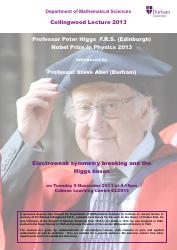The 2012/13 Collingwood Lecture
The 2013 Collingwood Lecture
Professor Peter Higgs (Emeritus, Edinburgh University)
Nobel Prize in Physics 2013
with
an introduction by
Professor Steve Abel (Department of Mathematical Sciences, Durham)
"Electroweak Symmetry Breaking and the Higgs boson"
5 November 2013, 4.15pm, CLC013 (Calman Learning Centre)
Abstract: The impressive developments in physics during the first half of the 20th Century made it seem likely that ALL phenomena, from the atomic scale to the edge of the visible universe, were governed solely by two known laws, that of classical general relativity, Einstein’s generalisation of Newtonian gravity, and quantum electrodynamics, the quantum version of Maxwell’s electromagnetic theory. But gravitational and electromagnetic interactions are long range forces, and the discovery of radioactive beta decay revealed the existence of a new, short range, force - the weak interaction. At the beginning of the 1960s, the theoretical interpretation of such weak interactions seemed to pose insuperable obstacles.
In 1964, Professor Peter Higgs, and independently, Professor Robert Brout together with Professor Francois Englert, postulated the existence of scalar fields pervading the universe (Brout-Englert-Higgs fields) that dynamically generate elementary particle masses and naturally give rise to weak short range forces. This insight opened up new perspectives on the unity of the laws of nature. It also predicted a new scalar particle.
On 4th July 2012 the international particle accelerator facility, CERN in Geneva, announced that it had discovered this particle, by then commonly referred to as `the Higgs', some 50 years after it was first predicted. This discovery was widely hailed as one of the most important advances of all time in our understanding of the Universe.
In this Collingwood lecture, Professor Abel explains why the Higgs became such a crucial guide to the mathematical underpinnings of Nature, beginning with the connection between symmetry and conservation laws, spontaneous symmetry breaking, the connection between mass and spin, and encompassing the Standard Model of particle physics. He also discusses why the discovery presents a difficult conundrum, and describes our current attempts to solve it.
Professor Higgs will provide an overview of the scientific circumstances that led to his insightful theoretical discovery in 1964.
